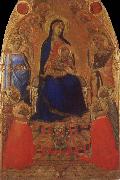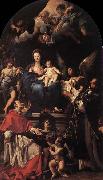Wholesale Oil Painting No Minimum |
|||||||||||
|
|
|||||||||||

|
|||||||||||
|
|
|
||||||||
Duccio di Buoninsegna1255-1318 Italian Duccio di Buoninsegna Locations Italian painter. He was one of the most important painters of the 14th century and like his slightly younger contemporary, Giotto, was a major influence on the course of Italian painting. An innovator, he introduced into Sienese painting new altarpiece designs, a dramatic use of landscape, expressive emotional relationships, extremely complex spatial structures and a subtle interplay of colour. His most important and revolutionary work, the Maeste for Siena Cathedral, was never matched during the 14th century, if at all, and his influence lasted well into the 15th century. |
||||||||
|
|
||||||||
Madonna and Child Enthroned with Angels and Saints
Madonna and Child Enthroned with Angels and Saints Painting ID:: 260 |
Museo dell'Opera del Duomo, Siena Museo dell'Opera del Duomo, Siena |
|||||||
|
|
||||||||
Maratta, CarloItalian Baroque Era Painter, 1625-1713 was an Italian painter of the High Baroque period, active mostly in Rome. Born in Camerano, then part of the Papal States. He came as a boy of 12 to apprentice in the studio of Andrea Sacchi. Like Sacchi, his paintings have a classicizing tone, inspired by the works of the great painters from Parma and Bologna: Carracci, Guercino, and Lanfranco. He developed a close relationship with Sacchi till the death of his master in 1661. He worked alongside Francesco Cozza, and Domenico Maria Canuti in the decoration of the Palazzo Altieri. His first prominent work is an Adoration of the Shepherds for San Giuseppe die Falegnami in 1650. He came to establish one of the most prominent art studios in Rome of his time. Other major works are the The Mystery of the Trinity Revealed to St. Augustine (c. 1655) painted for the church of Santa Maria dei Sette Dolori, The Appearance of the Virgin to St. Philip Neri (c. 1675) now in the Pitti Palace of Florence, The Virgin with Saints Carlo Borromeo and Ignatius of Loyola and Angels (c. 1685) for the church of Santa Maria in Vallicella, and The Assumption of the Virgin with Doctors of the Church (1689) for Santa Maria del Popolo, . His numerous depictions of the Virgin earned him the nickname Carluccio delle Madonne (Little Carlo of the Madonnas). The style of Maratta is a classicized Baroque, more restrained and composed than the styles of Cortona and Carracci, thus more allied to the traditions of Sacchi, Albani, and Reni. He was one of the artists favored by Giovanni Bellori. Maratta was known for his insightful portraiture. In 1650, Maratta was introduced to pope Alexander VII, who commissioned many paintings including one of his greatest works, a painting of Constantine destroying the idols for the Baptistry of the Lateran. This work brought Maratta increased fame in the Vatican, and in 1704 Maratta was knighted by pope Clement XI. Other works include an altarpiece in the San Francesco Saverio Chapel of the Church of the Gesu, in the right transept. In 1679 or 1680, a daughter, Faustina Maratti Zappi was born to Maratta by a mistress, |
||||||||
|
|
||||||||
|
|
Madonna and Child Enthroned with Angels and Saints
Madonna and Child Enthroned with Angels and Saints Painting ID:: 19280 |
1680-90
Oil on canvas
Saint Maria in Vallicella, Rome 1680-90 Oil on canvas Saint Maria in Vallicella, Rome |
||||||
|
|
||||||||
Ambrogio LorenzettiItalian Byzantine Style Painter, ca.1290-1348 Ambrogio Lorenzetti (or Ambruogio Laurati; c. 1290 ?C June 9, 1348) was an Italian painter of the Sienese school. He was active between approximately from 1317 to 1348. His elder brother was the painter Pietro Lorenzetti. His work shows the influence of Simone Martini, although more naturalistic. The earliest dated work of the Sienese painter is a Madonna and Child (1319, Museo Diocesano, San Casciano). His presence was documented in Florentine up until 1321. He would return there after spending a number of years in Siena. The frescoes on the walls of the Hall of the Nine (Sala dei Nove) or Hall of the Peace (Sala della Pace) in the Palazzo Pubblico of Siena are one of the masterworks of early renaissance secular painting. The "nine" was the oligarchal assembly of guild and monetary interests that governed the republic. Three walls are painted with frescoes consisting of a large assembly of allegorical figures of virtues in the Allegory of Good Government . In the other two facing panels, Ambrogio weaves panoramic visions of Effects of Good Government on Town and Country, and Allegory of Bad Government and its Effects on Town and Country (also called "Ill-governed Town and Country"). The better preserved "well-governed town and country" is an unrivaled pictorial encyclopedia of incidents in a peaceful medieval "borgo" and countryside. The first evidence of the existence of the hourglass can be found in one of his paintings. Like his brother, he is believed to have died of bubonic plague 1348. Giorgio Vasari includes a biography of Lorenzetti in his Lives. |
||||||||
|
|
||||||||
|
|
Madonna and Child Enthroned with Angels and Saints
Madonna and Child Enthroned with Angels and Saints Painting ID:: 40145 |
mk156
c.1340
Tempera on panel
50.5x34.5cm
mk156 c.1340 Tempera on panel 50.5x34.5cm |
||||||
|
|
||||||||
Carlo MarattiItalian Baroque Era Painter, 1625-1713,Italian painter, draughtsman and printmaker. He was the last major Italian artist of the classical tradition that had originated with Raphael, and his pre-eminence among the artists of his time marks the triumph of classicism. Nonetheless his art unites the virtues of disegno and colore, and he created a grandiose and decorative style that satisfied the demands of the Church. |
||||||||
|
|
||||||||
|
|
Madonna and Child Enthroned with Angels and Saints
Madonna and Child Enthroned with Angels and Saints Painting ID:: 51211 |
1680-90
Oil on canvas 1680-90 Oil on canvas |
||||||
|
|
||||||||
|
Carlo Maratti Italian Baroque Era Painter, 1625-1713,Italian painter, draughtsman and printmaker. He was the last major Italian artist of the classical tradition that had originated with Raphael, and his pre-eminence among the artists of his time marks the triumph of classicism. Nonetheless his art unites the virtues of disegno and colore, and he created a grandiose and decorative style that satisfied the demands of the Church. Madonna and Child Enthroned with Angels and Saints 1680-90 Oil on canvas |
||||||||
|
|
||||||||
|
Prev Next
|
||||||||
|
|
||||||||
|
Related Paintings to Carlo Maratti :. |
||||||||
|
|
||||||||
|
CONTACT US |




